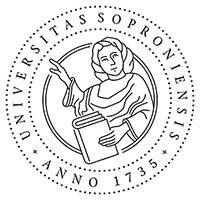Possibilities of Applying Qualitative Research Methods During the Measurement of Health Behavior in Adolescents
DOI:
https://doi.org/10.17165/TP.2016.3-4.13Abstract
A number of international research was made in the recent years to explore the health behavior of adolescents, most of them supported health behavior indicators with statistical data by applying quantitative research methods. Only a few researches volunteered to explore deeper correlations of health behavior with the help of qualitative tools. It is a feature of quantitative studies that specific phenomena appear as quantified, "coded" clusters of statistical data, from which apparently valid generalizations and trends emerge. Individual manifestations, along with those important aspects of phenomena that are personally important from the point of the individuals, giving the essence of relation systems which establish social processes remain hidden. Consequently, the researcher is unable to reveal the depths of the tested phenomenon only indicate trends. However, the qualitative methodology by exploring individual perspectives may result in the understanding of deeper correlations which may contribute to a more nuanced interpretation of the observed phenomena. When examining the health behavior of adolescents the use of qualitative tools may be the income of the knowledge of visible life parameters, the value attitude concerning health, motivation to choose healthy/unhealthy and thinking structures.
References
Anderson, Allan R. & Henry, Carolyn S. (1994). Family system characteristics and parental behaviors as predictors of adolescent substance use. Adolescence, 29(114), pp. 405–420. Retrived from: http://www.highbeam.com/doc/1G1-15622145.html [2014.07.30.]
Aszmann Anna (ed.) (2003). Iskoláskorú gyermekek egészségmagatartása. Budapest: OGYEI Deutsch Krisztina (2011). Iskolai egészségfelfogás és egészségfejlesztés kvalitatív és kvantitatív kutatások tükrében. Új Pedagógiai Szemle. 2011/1.-2.-3.-4.-5. szám. pp. 225–234.
Elekes Zsuzsanna (2007).Változó trendek, változó szerfogyasztási szokások. A budapesti középiskolások alkohol- és egyéb drogfogyasztási szokásai, 1992–2007. Addiktológia, 3. évfolyam, pp. 189–211.
Elekes Zsuzsanna (2009). Egy változó kor változó ifjúsága. Fiatalok alkohol- és egyéb drogfogyasztása Magyarországon – ESPAD 2007. Budapest: L’Harmattan Kiadó, pp. 41–49.
Falus Iván (ed.) (1993). Bevezetés a pedagógiai kutatás módszereibe. Budapest: Keraban Könyvkiadó
Karácsony Ilona, Nemes Anna, Harjánné Brantmüller Éva (2015). Netfogyasztási szokások veszélye középiskolás fokon In: Nagyházi Bernadette (ed.): IX Képzés és Gyakorlat Nemzetközi Neveléstudományi Konferencia: Neveléséstudomány, neveléstudomány a 21. században. Tanulmánykötet. 2015. pp. 308–321.
Krippendorff, Klaus (1995). A tartalomelemzés módszertanának alapjai. Budapest: Balassi Kiadó
Németh Ágnes & KöltőAndrás (eds.) (2011). Serdülőkorú fiatalok egészsége és életmódja Retrived from: http://www.ogyei.hu/anyagok/HBSC_2010.pdf [2011. október 15.]
Pál Katalin & Harjánné Dr. Brantmüller Éva (2012). A pedagógusképzés és a jövő pedagógusai előtt álló kihívások az egészségnevelés és az egészségfejlesztés területén. HERJ – Hungarian Educational Research Journal, 2:(2), pp. 1–7.
Petőné, Melinda Csima (2012). A tragedy in the margin, or the „West Balkan’s” message. Hungarian Educational Research Journal, II. vol 4. pp. 46–55.
Pikó Bettina (2002). Egészségszociológia. Budapest: Új Mandátum Könyvkiadó
Pikó, BF. & Fitzpatrick KM. (2004). Substance use, religiosity, and other protective factors among Hungarian adolescents. Addictive behaviors, 29(6), pp. 1095–1107. doi: https://doi.org/10.1016/j.addbeh.2004.03.022
Podráczky Judit (2010): Diszkurzív módszereket támogató elemzési technikák. In.: Gyermeknevelés–pedagógusképzés. Az ELTE Tanító- és Óvóképző Karának Tudományos Közleményei, XXXII. Budapest: ELTE EötvösKiadó, pp. 13–22.
Sántha Kálmán (2007). Beavatkozás nélküli vizsgálat. Új Pedagógiai Szemle, 2007/7, pp. 68–77.
Szabolcs Éva (2001). Kvalitatív kutatási metodológia a pedagógiában. Budapest: Műszaki Könyvkiadó
Tistyán et al. (2011). A dizájnerdrogok Magyarországon 2010–11-ben. Pécs: Fact Intézet. Retrived from: http://fact.hu/sites/default/files/dizajner_drogok_Magyarorszagon_zaro.pdf [2016. március 14.]
Downloads
Published
Issue
Section
License
Copyright (c) 2016 Csima Melinda

This work is licensed under a Creative Commons Attribution-NonCommercial-NoDerivatives 4.0 International License.








